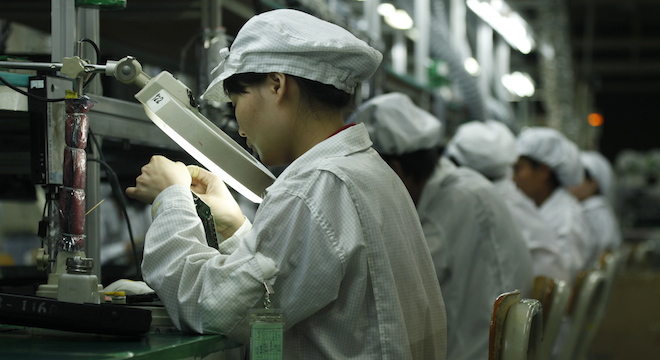The public radio program This American Life on Friday announced it was retracting the entirety of an episode it aired on the reportedly deplorable working conditions at a Chinese factory owned by Apple supplier company Foxconn, because the episode “contained significant fabrications.”
The original episode, “Mr. Daisey Goes To The Apple Factory,” which aired in late January, featured the supposedly firsthand account of American theatrical performer Mike Daisey traveling to Foxconn’s factory in Shenzhen, China.
Daisey, who also regularly performs a theatrical reading in New York City based on his experience in China called “The Agony and Ecstasy of Steve Jobs,” told This American Life and listeners that he met and spoke with Foxconn workers, who reported the company hiring 13-year-old employees and having them work inhumane hours in dangerous conditions.
However, Rob Schmitz, a reporter for another public radio program, Marketplace, was able to track down Daisey’s original interpreter. Schmitz told TPM that the translator disputed “every single important detail” of Daisey’s story, “save for a few minor details that actually did happen.”
Schmitz, who lives in Shanghai and is Marketplace‘s only China correspondent, said it’s “disheartening to see someone come to China for six days and then fabricate these stories.”
“Everything that I try to do — be honest, be accurate, be a good reporter — he undoes a lot of that,” Schmitz added. Schmitz and Glass will confront Daisey during this week’s episode of This American Life. Schmitz said Daisey admits to getting some of the story wrong, but digs his heels in on other parts.
This American Life host Ira Glass said in a blog post Friday that Mike Daisey “lied” to him and the show’s producers and “misled” them during the fact-checking process on the story, which was undertaken before it aired. As Glass continues: “That doesn’t excuse the fact that we never should’ve put this on the air. In the end, this was our mistake.”
As such, This American Life will devote the entirety of its show on Sunday to explaining just what was falsified or couldn’t be corroborated in Daisey’s original report. The episode is fittingly titled, “Retraction.”
Some of what Daisey fabricated has already been outlined on the This American Life blog. For example, the fact that Daisey said that there was no way to reach his original interpreter.
“During fact checking before the broadcast of Daisey’s story, This American Life staffers asked Daisey for this interpreter’s contact information. Daisey told them her real name was Anna, not Cathy as he says in his monologue, and he said that the cell phone number he had for her didn’t work any more. He said he had no way to reach her.”
This American Life also explains other fabrications big and small:
Some of the falsehoods found in Daisey’s monologue are small ones: the number of factories Daisey visited in China, for instance, and the number of workers he spoke with. Others are large. In his monologue he claims to have met a group of workers who were poisoned on an iPhone assembly line by a chemical called n-hexane. Apple’s audits of its suppliers show that an incident like this occurred in a factory in China, but the factory wasn’t located in Shenzhen, where Daisey visited.
“It happened nearly a thousand miles away, in a city called Suzhou,” Marketplace’s Schmitz says in his report. “I’ve interviewed these workers, so I knew the story. And when I heard Daisey’s monologue on the radio, I wondered: How’d they get all the way down to Shenzhen? It seemed crazy, that somehow Daisey could’ve met a few of them during his trip.”
In Schmitz’s report, he confronts Daisey and Daisey admits to fabricating these characters.
“I’m not going to say that I didn’t take a few shortcuts in my passion to be heard,” Daisey tells Schmitz and Glass. “My mistake, the mistake I truly regret, is that I had it on your show as journalism, and it’s not journalism. It’s theater.”
This American Life also explains that one of the most arresting moments in the show was an outright lie:
Daisey’s interpreter Cathy also disputes two of the most dramatic moments in Daisey’s story: that he met underage workers at Foxconn, and that a man with a mangled hand was injured at Foxconn making iPads (and that Daisey’s iPad was the first one he ever saw in operation). Daisey says in his monologue:
He’s never actually seen one on, this thing that took his hand. I turn it on, unlock the screen, and pass it to him. He takes it. The icons flare into view, and he strokes the screen with his ruined hand, and the icons slide back and forth. And he says something to Cathy, and Cathy says, “he says it’s a kind of magic.”
Daisey defended his work on his personal blog Friday, writing: “what I do is not journalism.”






